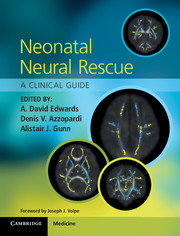Book contents
- Frontmatter
- Contents
- List of contributors
- Foreword
- Section 1 Scientific background
- Section 2 Clinical neural rescue
- 6 Challenges for parents and clinicians discussing neuroprotective treatments
- 7 The pharmacology of hypothermia
- 8 Selection of infants for hypothermic neural rescue
- 9 Hypothermia during patient transport
- 10 Whole body cooling for therapeutic hypothermia
- 11 Selective head cooling
- 12 Hypothermic neural rescue for neonatal encephalopathy in mid- and low-resource settings
- 13 Cerebral function monitoring and EEG
- 14 Magnetic resonance imaging in hypoxic–ischaemic encephalopathy and the effects of hypothermia
- 15 Novel uses of hypothermia
- 16 Neurological follow-up of infants treated with hypothermia
- 17 Registry surveillance after neuroprotective treatment
- Section 3 The future
- Index
- References
17 - Registry surveillance after neuroprotective treatment
from Section 2 - Clinical neural rescue
Published online by Cambridge University Press: 05 March 2013
- Frontmatter
- Contents
- List of contributors
- Foreword
- Section 1 Scientific background
- Section 2 Clinical neural rescue
- 6 Challenges for parents and clinicians discussing neuroprotective treatments
- 7 The pharmacology of hypothermia
- 8 Selection of infants for hypothermic neural rescue
- 9 Hypothermia during patient transport
- 10 Whole body cooling for therapeutic hypothermia
- 11 Selective head cooling
- 12 Hypothermic neural rescue for neonatal encephalopathy in mid- and low-resource settings
- 13 Cerebral function monitoring and EEG
- 14 Magnetic resonance imaging in hypoxic–ischaemic encephalopathy and the effects of hypothermia
- 15 Novel uses of hypothermia
- 16 Neurological follow-up of infants treated with hypothermia
- 17 Registry surveillance after neuroprotective treatment
- Section 3 The future
- Index
- References
Summary
Introduction
Clinicians worldwide are encouraged by the results of the large randomized controlled trials (RCTs) and systematic reviews that demonstrated the efficacy of hypothermia in improving neurologic and developmental outcomes in term and late preterm infants with hypoxic–ischaemic encephalopathy (HIE) [1–5]. These studies have brought an increased interest in the aetiology, recognition, management and outcome of encephalopathic infants. Based on these studies, many clinicians have started or are considering offering therapeutic hypothermia for the treatment of HIE. As more infants are receiving treatment, registries have been and are being developed that use observational study methods to gain insight and information regarding neonatal encephalopathy (NE) and therapeutic hypothermia outside of RCTs. This chapter will focus on how these registries shed light on how effective this emerging therapy will be in the real world setting and how the registry method may track adverse events that occur in frequencies too rare to be discovered in the trials that proved efficacy. One can anticipate that centres will be using this therapy for infants outside of the inclusion parameters and methods designated by the initial trials; registries will track this “therapeutic drift”. The registries also document the evaluations and treatments that a typical infant receives and are ideally suited to track the dissemination of adjunctive therapies as they arise. Registries are able to obtain information on the larger cohort of infants with neonatal encephalopathy in addition to smaller subsets of those cooled. Last, this chapter will focus solely on infants receiving therapy and report on the characteristics and initial results of the two registries currently in use: the United Kingdom TOBY Cooling Register (TOBY Register) and the Vermont Oxford Network Neonatal Encephalopathy Registry (VON NER).
Efficacy versus effectiveness
Despite the efficacy and relative safety demonstrated by the recent trials, many questions exist with regards to the safety, refinement and optimization of the procedure. Future randomized controlled trials of hypothermia versus normothermia will be difficult to perform as randomization to a normothermic control group could be construed as unethical [6]. To further study encephalopathic infants and monitor the practice of therapeutic hypothermia, research methods beyond RCTs are indicated. Although RCTs are considered the foundation by which we determine whether a given intervention is efficacious, they are ill suited to address issues such as safety monitoring and establishing effectiveness in a real world setting.
- Type
- Chapter
- Information
- Neonatal Neural RescueA Clinical Guide, pp. 182 - 194Publisher: Cambridge University PressPrint publication year: 2013



